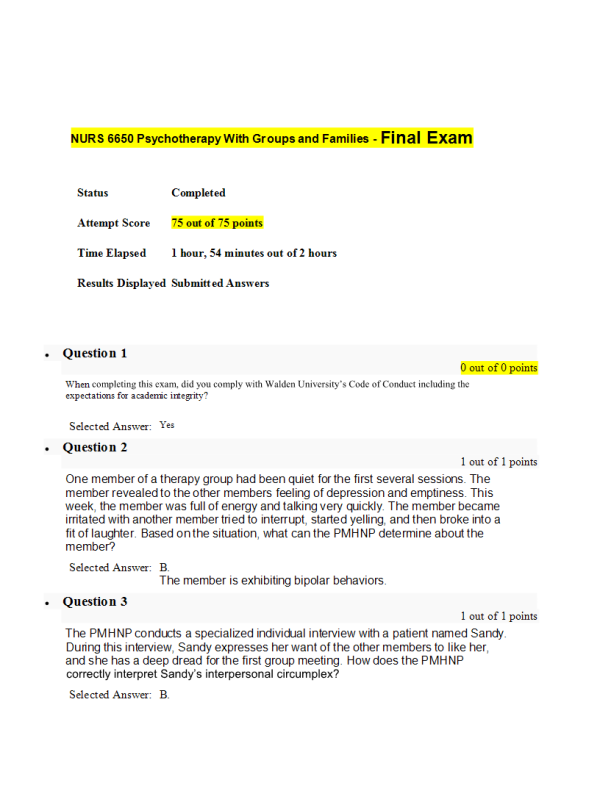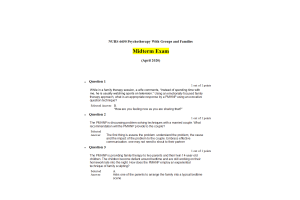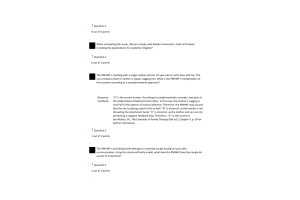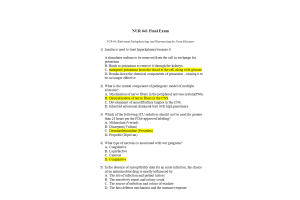NURS 6650 Final Exam75 out of 75 Points (Summer Quarter)
Course : NURS 6650 Psychotherapy With Groups and Families
Contributed : Edwards
- $49.00
NURS 6650 Psychotherapy With Groups and Families
- Question: When completing this exam, did you comply with Walden University’s Code of Conduct including the expectations for academic integrity?
- Question: One member of a therapy group had been quiet for the first several sessions. The member revealed to the other members feeling of depression and emptiness. This week, the member was full of energy and talking very quickly. The member became irritated with another member tried to interrupt, started yelling, and then broke into a fit of laughter. Based on the situation, what can the PMHNP determine about the member?
- Question: The PMHNP conducts a specialized individual interview with a patient named Sandy. During this interview, Sandy expresses her want of the other members to like her, and she has a deep dread for the first group meeting. How does the PMHNP correctly interpret Sandy’s interpersonal circumplex?
- Question: A PMHNP has been holding group therapy sessions for several weeks and notices that a patient is timid and predictable in his or her responses. When the patient does speak, he or she avoids saying anything to contradict anyone in the group. Based on this information, what is an appropriate question the PMHNP should ask herself?
- Question: When discussing the role of the consultant in the parenting group session, Dr. Carlson explains that the consultant should use several skills in order to help keep the group going and should enable group members to become very engaged with one another. The consultant should use all of the following skills to achieve this, except:
- Question: During an initial screening session, the PMHNP is considering a patient for group therapy. The patient is recently divorced and says he is lonely and depressed. What is the best referral by the PMHNP?
- Question: A PMHNP is leading a group therapy session for patients with substance abuse problems. After a productive session in which all members participated, the following week was not as productive. In order to help the group members assume responsibility for evaluating the meeting, what is an appropriate comment for the PMHNP to make?
- Question: Following the PMHNP’s cancellation of a group session, he or she notices a decrease in compliance and attendance within the group. What does the PMHNP identify as the group’s reason for noncompliance?
- Question: A client has attended five group therapy sessions yet has not engaged verbally with others in the group. The PMHNP has identified the client as a “silent member.” Which statement is true about silent members as related to group therapy?
- Question: For several months, a patient in group therapy always participated in conversation but only shared positive stories about her own life. During the next session, she finally confessed that she has been depressed and cutting herself. What is the best response by the PMHNP?
- Question: A 14-year-old girl named Laura and her parents are meeting with a PMHNP. The parents explain why they are there by saying, “Laura has been unhappy since she moved to a new school. She has been moody and often talks back to us.” Laura sits quietly and looks uncomfortable. Which is the best response by the PMHNP?
- Question: Members of a therapy group have been meeting for several weeks. While a member named Margaret is talking about how her spouse ignores her when she tries to tell him what to do, another member named Nicole interrupts and says, “Maybe he thinks you are being bossy.” Margaret replies by saying, “At least I’m not an alcoholic like you are!” What is an appropriate response by the PMHNP?
- Question: Group participation is an important aspect of how successful group therapy will be. The PMHNP recognizes that the gender of group participants can play a role in the likelihood of group participation. Which statement about gender and group composition does the PMHNP take into account?
- Question: A patient has had a problem with substance use and has been receiving treatment for addiction. Which additional step might the PMHMP suggest to help the patient maintain abstinence from drugs during and after treatment?
- Question: Jane has been attending group therapy for the past year; she and the therapist have determined that she has met her goals. Jane has been arriving to group late or not coming to group at all. How does the PMHNP correctly interpret Jane’s behavior?
- Question: Peter, a successful businessman, is introduced to the group during the twelfth week. Following Peter’s introduction, Joseph, a long-term member in the group, begins to lead the group and discuss all of the things that he has personally accomplished. In what way does the PMHNP correctly interpret Joseph’s behavior?
- Question: When the counselor discussed assertiveness with the group members, she began the session by providing definitions and asking group members to line up consistent with where they feel they are currently in terms of assertiveness. Why did she do this?
- Question: A 21-year-old client with narcissistic traits is noted to continuously disrupt the group by speaking while others are speaking. It becomes evident that the client is purposely disrupting the group and decreasing the group’s productivity. What does the PMHNP identify as a cause of the client’s behavior?
- Question: A narcissistic patient was unhappy that other members did not seem concerned about his or her dating problems, which the patient spent half the session talking about. The patient confronted the group by saying, “All of you are rude and uncaring!” When group members ignored this comment, the patient said, “And no one said anything nice about my new haircut either!” What is an appropriate response by the PMHNP?
- Question: During a group session, a member turns to the PMHNP and says, “I need some advice. My manager asked me to take on an extra project, and now I’m overwhelmed. I don’t want to seem incompetent, so I agreed to the extra work. What do you recommend I do?” What is the best response by the PMHNP in order to shape group behavior?B
- Question: In a group therapy session for patients with anxiety problems, a patient named Eve was afraid to disclose to the other members that she was a victim of sexual abuse. She kept the secret for months, although she hinted at it to other members. During a meeting, another member tried to pressure Eve to disclose her secret, but she was flustered and not ready to share. What is an appropriate response by the PMHNP?
- Question: A PMHNP is leading a group therapy session for patients with substance abuse problems. After one member shares a problem, other members offer support, concern, and observations. The PMHNP points out that the group is offering many truthful reactions and helpful feedback. Which principle does this illustrate?
- Question: During an initial meeting, a PMHNP spends time speaking with a patient who suffers from social anxiety. The therapist finds the patient extremely loud and overbearing. The PMHNP’s negative feelings continue no matter how hard he or she tries to feel differently toward the patient. What is the most appropriate next step by the PMHNP?
- Question: The PMHNP recognizes that hostility is unavoidable in a group and acknowledges that a frequent source of hostility can be parataxic distortions. Which situation is likely to present a parataxic distortion within the group?
- Question: During the “mid-group debrief” the clinical supervisor focused on the following areas with the two counselors except:
- Question: Harold Wyman is a 74-year-old man who is trying to mend a relationship with his adult daughter. Based on his intake assessment, the PMHNP believes that the father has depression. The daughter and Harold meet with the PMNHP, and the daughter explains that her father always appears mopey and withdrawn and refuses to do anything about it. When asked, the father reports feeling sad all the time. Which action will the PMNHP employ with Harold using the interpersonal psychotherapy approach throughout the various sessions?
- Question: A patient who has been depressed is seeing a PMHNP for individual therapy. The patient explains that he has been avoiding most social activities for the past few months. He is divorced and has joint custody of his 10-year-old daughter. Based on this information, what recommendation by the PMHNP would most benefit the patient?
- Question: The PMHNP explains during a discussion that subgrouping has the potential to make group therapy more complicated and less rewarding. Tara, a member of the group, angrily states, “Well, Jack and I have been meeting outside of the group for weeks now.” What is the PMHNP’s most appropriate response?
- Question: Members of group therapy have been meeting for several weeks. The PMHNP often starts sentences with a thank you or compliment such as, “Good observation.” The PMHNP notices that some of the group members having been starting their statements with compliments. To which principle can the PMHNP attribute this process?
- Question: Many key principles assist with composing intensive interactional psychotherapy groups. When composing a psychotherapy group, utilizing the intensive interactional approach, which key principle does the PMHNP identify as being false?
- Question: Members of a therapy group have been meeting for several months. During group therapy, a patient is bossy and controlling. During this week’s session, she is confronted by another group member about her behavior and replies, “This is not how I normally act. You are not my family and friends. I don’t act the same way around them.” What can the PMHNP deduce from her behavior?
- Question: The PMHNP is meeting with an older married couple. The couple reports having concerns about becoming dependent on their adult children someday, since several of their other friends have had to move in with their kids. They make it clear to the PMHNP that they aren’t keen on therapy or taking medicine but would be willing to try some alternative therapies. What does the PMHNP suggest for evidence-based CAM modalities?
- Question: The PMHNP understands that conflicts within the psychotherapy group can be troublesome for clients and have the potential to reduce the effectiveness of the group process. As it pertains to group meetings, the PMHNP understands which statement to be true about conflict?
- Question: During a group therapy session, a member comments that another member named Ted had no compassion. Ted replies, “Why does it matter if I care one way or another. I can’t solve their problems.” The other member starts crying and blames Ted for this. He shrugs and answers, “I don’t understand why you are crying.” Based on this information, what is the most likely determination the PMHNP can make about Ted?
- Question: During a first group therapy session, a member is outgoing and participates actively. Based on this information, what is an appropriate prediction about this group member by the PMHNP?
- Question: A PMHNP has a therapy group in which many members have been dropping out over the past several weeks. Members have complained that they do not feel part of the group. What is an appropriate step for the PMHNP to take?
- Question: A PNHNP is holding a group therapy session for a father and his 10-year-old son, whom the father explains has been acting out lately. The son says, “He is always telling me what to do and never listens when I have an idea.” Which solution would the PMHNP most likely suggest as an approach to the problem?
- Question: A patient has attended three group therapy sessions and has remained silent throughout each. The patient has, however, been listening to the other members. When the therapist makes eye contact with the patient, he or she forces a smile but has clenched fists. What is the most appropriate response by the PMHNP to help the patient? A
- Question: A member in group therapy named Tom asked others for suggestions to a problem he was having. He did not think a suggestion by a member named Steve would work, and for the rest of session, the group took sides arguing why the idea would work or would not work. The session ended with Tom agreeing to try the suggestion and report back to the group the following week. Based on this session, what is an appropriate step by the PMHNP?B
- Question: A patient named Tyrone was nervous sharing personal information with the group. To compensate, he makes comments on other members’ problems as if he were the therapist. Another member of the group asked him, “Do you think you’re better than everyone here?” What might the PMHNP help Tyrone gain from this exchange?
- Question: A patient in group therapy discloses her concern about feeling suicidal again in the future. Using the principle of universality, what is an appropriate step by the PMHNP?
- Question: In the parent consultation session, the parent discusses her son “Blake” who has changed since his 13th birthday. Dr. Carlson discusses the power conflict that the parent appears to be getting into with her son. When they discuss approaches they can use to help Blake experience increased responsibility, Dr. Carlson explains that the parent must make a commitment with her son by agreeing to:
- Question: A patient in group therapy, Monique, describes another member, Anna, as bossy and selfish; however, the PMHNP does not notice this behavior at all. In addition, other members have expressed how thoughtful and caring Anna is to them. Based on this information, what is an appropriate observation by the PMHNP?
- Question: During a group therapy session, a member shares that she often feels lonely and depressed. She has been turning down invitations to spend time with friends lately, because she does not want to leave the house. What is an appropriate step for the PMHNP to take?
- Question: The social microcosm theory is a theory that relates to group composition. In accordance with this theory, the PMHNP is aware that the group must consist of which of the following?
- Question: A client is observed discussing many problems and complaints during group therapy. However, when other group members attempt to offer advice, the client does not accept it. Based on this observation, what can the PMHNP determine about the client?
- Question: The PMHNP is meeting with an adult woman and her father, who is 85 years old. The father stays quiet most of the session. The daughter explains he is mad at her for “bringing him to a see a shrink.” The daughter reports that things have been tense in the house since her father moved in. The father has a history of depression, though he does not take any medication for it. In addition, lately the father seems to never sleep. “I hear him rummaging around in the kitchen, the garage, the living room, at all hours of the night. Sometimes he’ll nap during the day, but not much. This is putting a strain on my marriage, because my husband can’t sleep with all of this going on.” Which therapeutic approach does the PMHNP identify as most appropriate for the 85-year-old father?
- Question: A patient in group therapy named Ted shares personal information for the first time. He seems nervous but continues to talk. How might the PMHNP use nonverbal positive reinforcement to support Ted’s feeling more comfortable?
- Question: A 36-year-old client attends group therapy regularly but is consistently tardy. The client explains that job and family obligations interfere with attendance to the group. What is the most appropriate intervention by the PMHNP?
- Question: A group member who suffers from depression and anxiety says during the session, “I don’t see how any of this is going to help. I am still too anxious to leave the house and do the things I want to do.” What is an appropriate response by the PMHNP?
- Question: A PMHNP is putting together a heterogeneous, interactional therapy group. During an initial screening, a patient explains that he is unemployed because he keeps getting fired from new jobs after several months. The therapist asks, “Why do you think those companies let you go?” The patient’s reply is, “Those companies are all terrible. They don’t know how to treat employees.” After asking the patient if he thought about his role in getting fired, the patient says, “Why should I? I am not part of the problem.” Based on this information, what is an appropriate observation by the PMHNP?
- Question: One group member is identified by the PMHNP as the monopolist of the group. Which behavior does the PMHNP believe this member is most likely to display?
- Question: The PMHNP provides cognitive behavioral therapy (CBT) to an older adult patient with depression. The patient’s 41-year-old daughter and 32-year-old son attend one of his sessions with the PMHNP so that they can learn more about how to help their father. What does the PMHNP say to the daughter and son about the goals of their father’s CBT?
- Question: In a group therapy session for adolescents, a 15-year-old patient says he has trouble making conversation with people he does not know well. Based on the principle of development of socializing techniques, what explicit approach might the PMHNP take?
- Question: A PMHNP is treating a 7-year-old child exhibiting signs of aggression and attention problems. Before suggesting an intervention using a common elements approach, what may the PMHNP consider?
- Question: A PMHNP is meeting with the mother of a 10-year-old boy named Malik, who has been depressed since his parents’ divorce. The mother explains that her goal for treatment is to help Malik feel better so he can become his “usual outgoing self.” She insists that she does not want him on medication. Which is the best response by the PMHNP?
- Question: A PNHNP is holding a group therapy session. Today, several members have expressed fears about being unlovable. Based on this information, what is an appropriate step by the PMHNP to raise the members’ self-esteem?
- Question: During an initial meeting, a patient who has been discussing suicide says to the PMHNP, “I’m so depressed that I don’t want to leave my house. All I want to do is stay in bed.”
- Question: During his second group therapy session, a member, who was quiet the previous week, becomes very judgmental. He criticizes another member by saying, “Mary, you are always late because you don’t respect our group.” Then he adds, “In fact, all of you are disrespectful and uncaring.” What is an appropriate step by the PMHNP?
- Question: A PMHNP notices that adolescents in a therapy group have not been getting along. They are divided into two main groups and each automatically dislikes members of the other group. What is an appropriate step for the PMHNP to take?
- Question: A PMHNP is treating an 8-year-old child who was at a cousin’s house during a domestic violence situation. Using a common factors model, the PMHNP wants to pay attention to cultivating the relationship with the parents and child. After the child talks about how nervous he or she has been since witnessing the trauma, what is an appropriate response by the PMHNP?
- Question: A client diagnosed with depression has begun to feel despair and expresses a desire to leave the group because he or she does not believe it is helpful. Which action by the PMHNP will most likely contribute to the client staying in the group?
- Question: A PMHNP is treating a patient in individual therapy and thinks the patient may be a good candidate for group therapy. The patient is motivated to start group therapy, which meets twice a month. Then the patient adds, “I can come to the first two meetings, but then will be away on business for at least a month, maybe longer. But then I can come to the at least one meeting before my next trip.” Based on this information, what is the most likely recommendation by the PMHNP? B
- Question: During therapy, a patient named Maria states she is unhappy that other members did not express missing her while she was away the previous week. She confronted the PMHNP by saying, “Nobody here cares about this stupid group!” What might the PMHNP say to increase group cohesiveness?
- Question: A PMHNP is meeting with parents and their 10-year-old child. The child is having trouble paying attention at school and has been getting easily frustrated at home when doing homework, which often results in everyone arguing. What step might the PMHNP take as part of a family-centered, solution-oriented approach?
- Question: A PMHNP is creating a therapy group and is including a patient with borderline personality disorder. Which action would most likely reduce the patient’s chance of separation anxiety?
- Question: When forming a group for therapy, which action would the PMHNP likely take as a predictor for group behavior?
- Question: The PMHNP is working with an older adult woman and her adult children. The children report that the mother was diagnosed with dementia, and they are all concerned about her welfare. The plan is for the mother to move in with one of the children, but they are still worried about how the mother will manage during the day when she is left alone. What does the PMHNP identify as the focus of the family therapy?
- Question: Gregory is a middle-aged veteran participant in a group led by the PMHNP. Since Gregory has been attending group, he frequently interrupts others and seems to take much of the group time for himself. The PMHNP identifies Gregory as a monopolist and confronts him. She explains that she does not want him to talk less; instead, she actually encourages him to talk more. What is the likely cause of the PMHNP’s explanation?
- Question: Two PMHNPs are in charge of a therapy group that has experienced several maladaptive interpersonal dramas lately. One of the patients has been described by other members as argumentative. After a particularly awkward session, one of the therapists feels that his own interpersonal distortion of the session may be clouding his observation. What is an appropriate step by that PMHNP?
- Question: A patient in group therapy for people dealing with panic disorder is describing a recent panic attack. He says, “During this attack, I felt like I was dying.” What is an appropriate response by the PMHNP using didactic instruction?
- Question: The PMHNP is meeting with a married couple. The husband is 81 years old, and the wife is 78 years old. They tell the PMHNP that many of their friends have passed away over the last couple of years, and it’s making them feel sentimental about their lives and the fact that they are getting older. Hearing this, the PMHNP uses a life review approach with the couple. What action will the PMHNP employ?
- Question: During the first group meeting, a client states, “I am here because I am very shy. I don’t mesh well with others and I rarely get invitations to go anywhere.” Which statement about the client’s reason for seeking help and treatment best applies?
- Question: According to Dr. Carlson, since Adler talked about how the social setting in which we live influences our lives, the best way parents can change their children’s behavior is to change:
- Question: Self-disclosure is a very important part of group therapy. Which of the following conditions does the PMHNP identify in his or her own life as a possible hindrance to self-disclosure?
- Question: The leader begins a group meeting by doing the “names activity.” At the completion of the activity, the leader explains that the activity is useful for all of the following reasons, except:



